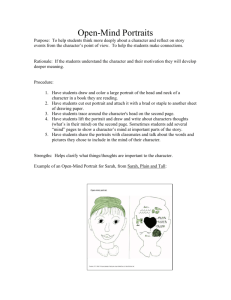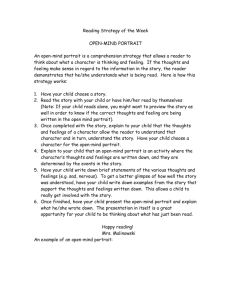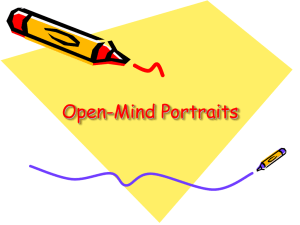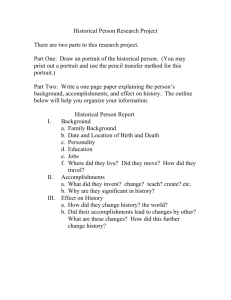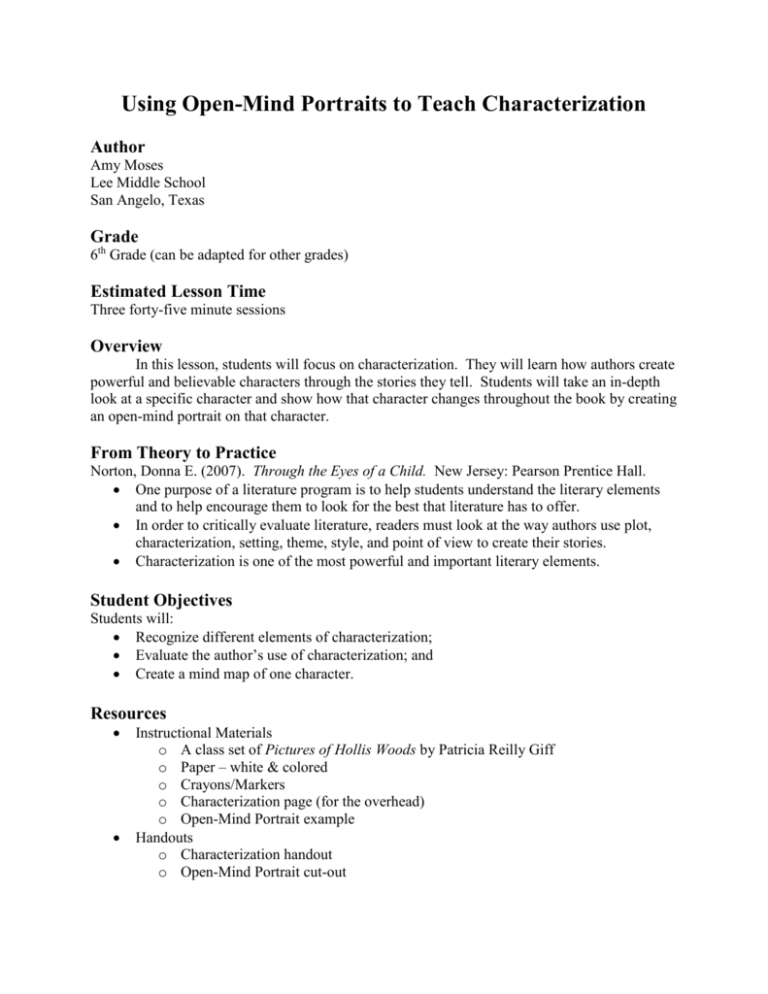
Using Open-Mind Portraits to Teach Characterization
Author
Amy Moses
Lee Middle School
San Angelo, Texas
Grade
6th Grade (can be adapted for other grades)
Estimated Lesson Time
Three forty-five minute sessions
Overview
In this lesson, students will focus on characterization. They will learn how authors create
powerful and believable characters through the stories they tell. Students will take an in-depth
look at a specific character and show how that character changes throughout the book by creating
an open-mind portrait on that character.
From Theory to Practice
Norton, Donna E. (2007). Through the Eyes of a Child. New Jersey: Pearson Prentice Hall.
One purpose of a literature program is to help students understand the literary elements
and to help encourage them to look for the best that literature has to offer.
In order to critically evaluate literature, readers must look at the way authors use plot,
characterization, setting, theme, style, and point of view to create their stories.
Characterization is one of the most powerful and important literary elements.
Student Objectives
Students will:
Recognize different elements of characterization;
Evaluate the author’s use of characterization; and
Create a mind map of one character.
Resources
Instructional Materials
o A class set of Pictures of Hollis Woods by Patricia Reilly Giff
o Paper – white & colored
o Crayons/Markers
o Characterization page (for the overhead)
o Open-Mind Portrait example
Handouts
o Characterization handout
o Open-Mind Portrait cut-out
Instructional Plan
Instruction and Activities
*Note: This lesson is based on the assumption that the students have already read the book.
These activities can be used with any book that has a round character.
Session 1
1. Ask the students to give a summary of the book.
2. Ask them about the main character, Hollis Woods and what they think of her.
3. Go over the characterization handout and what makes interesting characters.
4. Have the students fill out the check-list on Hollis Woods, citing evidence from the text.
5. Discuss whether or not the author did a good job creating Hollis’ character.
Session 2
1. The places Hollis Woods has lived can be divided into three or four parts: the forgettable
homes before the Reagan’s, the Reagan home, Josie’s home, and Hollis’ final home.
Hollis undergoes many changes as she moves from home to home. Talk to the students
about the changes she goes through at each house and what she thinks and feels.
2. Explain to students how to make an open-mind portrait.
a. Draw and color a large portrait of the head and neck of the character, Hollis.
b. Cut out the portrait and trace around the character’s head on several more sheets
of paper.
c. Students will create a mind page for each home that Hollis has lived in (as
described in step 1). These pages will show what the character is thinking and
feeling at each home in the story. They are made by illustrating and writing about
the character from the character’s viewpoint.
d. Cut out the mind pages and place them in order.
e. Attach the portrait and mind pages with a brad.
f. Share the open-mind portraits with classmates and talk about the words and
pictures they chose to include and why.
3. Direct the students to create their own open-mind portraits about Hollis Woods. They
will need to create a portrait with 4 mind pages. They can even create a second portrait
to show how her physical appearance has changed by the end of the book (or how she
sees herself).
Session 3
1. Students will need to finish their open-mind portraits today.
2. When they are finished, have the students share their portraits and explain the
illustrations and reasons for choosing them. You could do this in author’s chair.
Extensions
Have the students create an open-mind portrait on another character in the book and
compare it to that of Hollis Woods.
Have the students create an open-mind portrait about another main character in another
book like Jesse Aarons in Bridge to Terabithia by Kathrine Paterson. Have them
compare the two characters.
Have the students write a sequel to the story. They could create some new problems for
Hollis and her family.
TEKS
6.11 Reading/literary response. The student expresses and supports responses to various
types of texts. The student is expected to:
o (B) interpret text ideas through such varied means as journal writing, discussion,
enactment, and media; and
o (C) support responses by referring to relevant aspects of text and his/her own
experiences.
6.12 Reading/text structures/literary concepts. The student analyzes the characteristics of
various types of texts (genres). The student is expected to:
o (F) analyze characters, including their traits, motivations, conflicts, points of view,
relationships, and changes they undergo.
Characterization
Authors develop memorable characters by:
Describing the character’s physical appearance
Recording conversations of the character
Revealing the character’s thoughts
Revealing the perceptions of other characters
Showing the character in action
Revealing the character’s strengths and weaknesses
Allowing readers to gain insights into the character’s pasts, hopes, and fears
Creating characters who undergo changes throughout the story
These characters:
Develop throughout the story
Change as they confront and overcome problems
Have several sides
Are round characters that have good and bad qualities
Have conflicts
o Person vs. self
o Person vs. person
o Person vs. society
o Person vs. nature
Characterization Checklist
Book: _________________________________
Author: _____________________________
Character: _________________________________________
Check off all that apply.
The author reveals the character’s:
Physical appearance
Conversations
Thoughts
Perception by others (how they see him/her)
Actions
Strengths
Weaknesses
Hopes
Fears
Past experiences
Changes he/she undergoes
Several sides
Conflicts
Evidence from the text:

